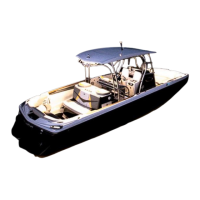and tight before and during use. When the tower is up,
watch for low obstacles such as tree limbs, bridges or
power lines.
Warning Plates and Labels
Read and note ALL warning plates and labels from bow to
stern, including those that are installed inside the engine compart-
ment, lockers and under seating. YOU MUST READ AND AD-
HERE TO ALL CAUTIONS AND WARNINGS IN AND ON
YOUR BOAT!
Operator’s Responsibilities
• Ensure the boat is in top operating condition and there are no
hazards that impede your moving about the boat.
• Ensure the bilge is clean prior to starting.
• File a oat plan, as described below, with a relative or friend.
• Have a complete knowledge of the operation and handling char
-
acteristics of your boat.
• Ensure that the boat is not loaded above the maximum capacity
and that the load is properly distributed.
• Have familiarity with your starting location and your goal, and the
waterways between.
• Maintain a safe speed at all times to avoid collisions.
• Keep an eye out for changing weather conditions and respond
accordingly.
• Know and practice the navigational rules. Know and obey all fed-
eral and state regulations and operate the boat properly around
all waterway markers.
• Maintain a clear, unobstructed view at all times, especially forward.
Scan the water and avoid tunnel vision. Many boating collisions
are caused by inattention.
Float Plan
A “oat plan” is a written record indicating the planned destination
and approximate length of time for the outing. Sample forms are avail-
able at the Coast Guard’s website. One should be completed and left
with a relative or friend prior to each trip. In case of an emergency or
failure to return within a reasonable period of time, pertinent informa-
tion will be available to assist local marine police or the Coast Guard in
determining whether a search should be performed. Be sure to notify
the oat plan holder upon return.
Nautical Charts
Nautical charts are especially important to boaters planning trips,
particularly on open waters. These charts show the nature and shape
of the coast, depths of water, general conguration and character of
the bottom. Other markings on the nautical charts include promi-
nent landmarks, port facilities, aids to navigation, and marine hazards.
Changes brought about by people and nature require that nautical
charts be constantly maintained and updated to aid safe navigation.
National Ocean Service (NOS) charts may be purchased either
directly by mail from the NOS Distribution Branch or through an au-
thorized agent. There are more than 1,700 nautical chart agents who
sell them.
FAA/National Aeronautical Charting Ofce
Distribution Division, AVN-530
6303 Ivy Lane, Suite 400
Greenbelt, MD 20770
Telephone: (301) 436-8301
Email: 9-AMC-chartsales@faa.gov
Website: http://naco.faa.gov/
Weather
Never leave the dock without rst checking the local weather forecast.
Weather information is available from television, radio, local newspaper, on-
line or from a weather channel on a VHF radio.
At certain times of the year, weather can change rapidly and boat-
ers should always keep an eye out for weather conditions. While boat-
ing, pay attention to the following:
• Weather changes generally come from the west.
• Watch for cloud build-up, especially rapid, vertically rising clouds.
• Sudden drop in temperature.
• Sudden change in wind direction and/or speed.
• On-board barometers should be checked every two-to-three
hours. A rising barometer indicates fair weather and a rise in wind
velocity; a falling barometer indicates stormy or rainy weather.
What to do in severe weather:
• Reduce speed, keeping enough power to maintain headway.
• Put on PFDs.
• Turn on running lights.
• Head for the nearest shore that is safe to approach, if possible.
• Head bow of boat into waves at about a 45-degree angle.
• Keep bilges free of water.
• Seat passengers on bottom of the boat, near the centerline.
• If the engine fails, tie a sea anchor on a line from the boat to keep
the boat headed into the waves. A bucket will work as a sea an-
chor in an emergency.
• Anchor the boat, if necessary.
Staying Afloat
It is commonly believed that someone dressed in heavy clothing
or waders will experience considerably more difculty staying aoat
if they fall overboard. This is not true. Air trapped in clothing provides
otation and bending the knees will trap air in waders. To stay aoat:
• Remain calm. Do not thrash about or try to remove clothing or
footwear. This leads to exhaustion and increases the loss of air
that may keep you aoat.
• Keep your PFD on.
• Keep your knees bent.
• Float on your back and paddle slowly to safety.
Cold Water Survival
Sudden immersion in cold water can induce rapid, uncontrolled
breathing, cardiac arrest and other physical body conditions, which
can lead to drowning. Always wearing a PFD will help survival in rapid
immersion situations.
mastercraft 2010 ow n e r ’s m anual • page 1-6

